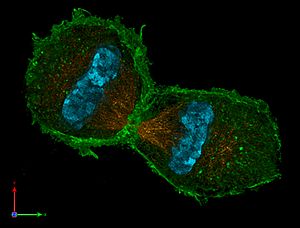Autopoiesis facts for kids

Autopoiesis (pronounced aw-toh-poy-EE-sis) is a fancy word that means "self-creation" or "self-production." It describes systems that can make and keep themselves going. Think of it like a living thing that builds and repairs itself without needing outside help for its basic parts.
This idea was first introduced in 1972 by two Chilean biologists, Humberto Maturana and Francisco Varela. They used it to explain how living cells constantly maintain their own chemistry and structure. Since then, the idea of autopoiesis has also been used to understand other complex systems, like how groups of people or even ideas can keep themselves going.
What is Autopoiesis?
Autopoiesis helps us understand what makes something "alive" or "lifelike." For a system to be called autopoietic, it needs to do three main things:
- It must produce its own parts.
- It must correctly put these parts together.
- It must continuously fix and maintain itself to stay in existence.
In simple terms, autopoietic systems are like self-repairing and self-reproducing machines. They create their own components and use them to rebuild and maintain themselves.
Why is this idea important?
This way of thinking uses ideas from how molecules work in biology and how systems are organized. It's special because it doesn't just focus on how life is organized here on Earth. The scientists who came up with autopoiesis believed that machines could also have these features. They also thought that other types of life, different from what we know, could exist and still be autopoietic.
This means the concept of autopoiesis helps us think about what "life" truly means, beyond just plants and animals. It opens up the possibility of understanding other self-sustaining systems, whether they are biological or not.
See also
 In Spanish: Autopoiesis para niños
In Spanish: Autopoiesis para niños

